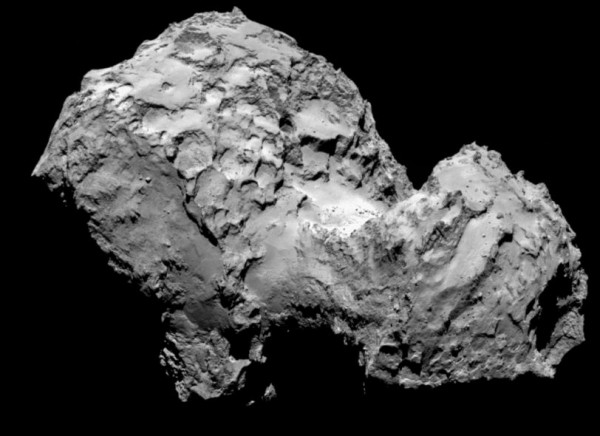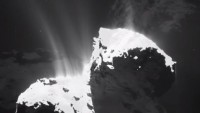Building Blocks of Life on Earth and the Universe Discovered on Comet 67P
| Arthur Dominic Villasanta | | May 28, 2016 08:24 AM EDT |
(Photo : ESA) Comet 67P as seen from Rosetta
The discovery of both glycine and phosphorous in the coma orbiting Comet 67P/Churyumov-Gersimenko by the Rosetta spacecraft is rock-solid evidence comets seeded the Earth with the organic molecules that gave birth to life on this planet.
It also supports the theory of "panspermia" that says life exists and is being spread throughout the Universe by meteoroids, asteroids, comets, planetoids, and also by microorganisms on spacecraft.
Like Us on Facebook
Scientists at the European Space Agency operating Rosetta have, for the first time, directly detected the amino acid glycine used by living organisms to make proteins, and other key organic compounds in comet 67P. They also announced that for the first time in a comet, the detection of phosphorous, an element present in all living organisms.
These results strengthen the theory comets delivered the chemical building blocks for life on Earth and are still doing so throughout the solar system and on other solar systems, as well.
ESA said Rosetta detected the glycine and phosporous in the coma or the cloud of gas and dust surrounding Comet 67P. The discovery implies that glycine is a common ingredient in parts of the universe where stars and planets have formed, said Rosetta scientist Kathrin Altwegg of the University of Bern in Switzerland, who led the research published in the journal Science Advances.
"Having found glycine in more than one comet shows that neither Wild 2 nor 67P are exceptions," said Altwegg. "Amino acids are everywhere, and life could possibly also start in many places in the universe."
University of Washington astronomer Donald Brownlee said meteorites and now comets prove the Earth has been seeded with many critical biomolecules over its entire history
"You need more than amino acids to form a living cell," Altwegg said. "It's the multitude of molecules which make up the ingredients for life." Rosetta is due to end its two-year mission at 67P by flying very close to the comet and then crash-land onto its surface this September.
Launched on March 2, 2004, Rosetta made a rendezvous with comet 67P on Aug. 6, 2014. On Nov. 12, the spacecraft's Philae lander performed the first successful landing on a comet.
TagsComet 67P/Churyumov-Gersimenko, rosetta spacecraft, glycine, phosphorous, european space agency
©2015 Chinatopix All rights reserved. Do not reproduce without permission
EDITOR'S PICKS
-

Did the Trump administration just announce plans for a trade war with ‘hostile’ China and Russia?
-

US Senate passes Taiwan travel bill slammed by China
-

As Yan Sihong’s family grieves, here are other Chinese students who went missing abroad. Some have never been found
-

Beijing blasts Western critics who ‘smear China’ with the term sharp power
-

China Envoy Seeks to Defuse Tensions With U.S. as a Trade War Brews
-

Singapore's Deputy PM Provides Bitcoin Vote of Confidence Amid China's Blanket Bans
-

China warns investors over risks in overseas virtual currency trading
-

Chinese government most trustworthy: survey
-

Kashima Antlers On Course For Back-To-Back Titles
MOST POPULAR
LATEST NEWS
Zhou Yongkang: China's Former Security Chief Sentenced to Life in Prison

China's former Chief of the Ministry of Public Security, Zhou Yongkang, has been given a life sentence after he was found guilty of abusing his office, bribery and deliberately ... Full Article
TRENDING STORY

China Pork Prices Expected to Stabilize As The Supplies Recover

Elephone P9000 Smartphone is now on Sale on Amazon India

There's a Big Chance Cliffhangers Won't Still Be Resolved When Grey's Anatomy Season 13 Returns

Supreme Court Ruled on Samsung vs Apple Dispute for Patent Infringement

Microsoft Surface Pro 5 Rumors and Release Date: What is the Latest?











